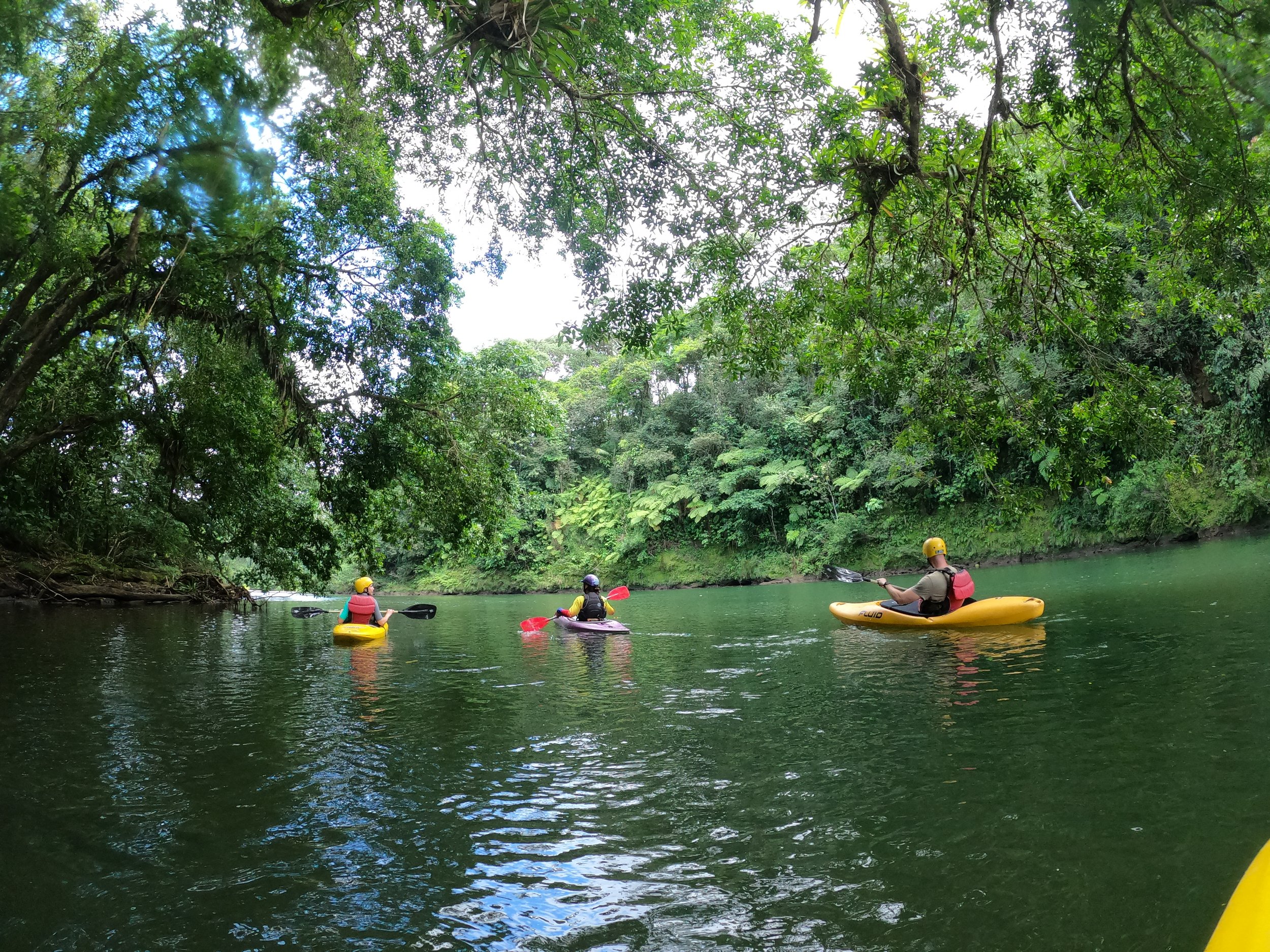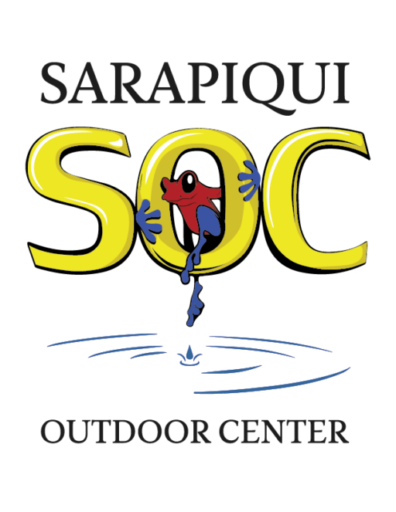
Introduction to Kayaking
Level 1
The Introduction to Kayaking course is designed as a short program emphasizing
safety, enjoyment and skill acquisition for entry level individuals in public, private, and commercial
settings.
ABOUT THE COURSE
Course Duration: The course duration should be adjusted to best fit the needs and goals of the
participants. Refer to sample outlines below for content and progression possibilities based on time
allowance. 1 day (6 hours)
Course Location / Venue: Sarapiqui Outdoor Center, Sarapiqui river Class I a II
Course Prerequisites: None
Instructors: ACA Level 3 Rafting - Paddle Instructor (Or higher)
Class Ratio: 5 Participants : 1 Instructor; with an additional instructor or qualified assistant the ratio can be 10 : 2
SCHEDULE
08:00 am
Monday to Sunday
* Please contact us if you wish to request another departure, everything is possible, just ask us.
PRICES
From $75USD
PER DAY
INCLUDES
-All equipment
-ACA Instructor certified
-Fruit snack
-Home made local style lunch
-Transportation from our base to and from the paddling sites
WHAT TO BRING
We recommend bringing:
- Swimsuit and/or shorts
- Sunscreen
- String or strap to secure your glasses
- Water shoes or sandals with ankle straps. No flip flops. Closed toe shoes recommended.
- Light rain jacket and/or polypropylene, wool shirts for cool or rainy days. Cotton T-shirts for sunny days only (they make you colder when wet).
CONTENTS
-
● Welcome, introductions, paperwork
● Student and instructor course expectations and limitations
● Course itinerary and site logistics
● Review waiver, assumption of risk, challenge by choice, medical disclosure
● About the ACA -
● Discuss weather conditions, forecasts, and other environmental hazards (wind, water, weather,
waves)
● Evaluate hazards to navigation
● Discuss importance of developing good judgment and group responsibility for a trip
● Evaluate individual’s ability, water comfort, and confidence prior to trip
● Warm up to reduce injury
● Make sure the boat is securely fastened to the car or racks, using proper tie downs, straps, or
knots.
● Review proper techniques to safely lift and carry the kayak on shore
● Review life jackets appropriate for the operator’s size, kayak, and activity, assuring all others in
the group are properly wearing their life jacket
● Inspect the kayak and all safety equipment to meet state, federal, and local requirements for the
vessel and activity
● Describe and follow safe boating practices (behavior, substance abuse, on water and land
etiquette, leave no trace ethics)
● Review elements of a float plan (Who, What, When, Where, filing practices)
● Review personal equipment needed for the kayak, activity and environment
● Prepare kayak for departure: stowing gear securely, and ensuring it is balanced
● How to hold the paddle in correct orientation and grip for effective paddling -
To be performed with appropriate and efficient strokes, while maintaining the trim and
balance of the craft
● Enter and launch kayak from shore in a controlled manner, checking for clear departure
● Propel the kayak forward in a straight line 15-20 boat lengths
● Stop the kayak within two boat lengths
● Move the kayak backwards 3-4 boat lengths
● Turn the kayak from a stationary position 180° to the right and left
● Move the kayak sideways 10 feet (3 meters) to each side
● Propel the kayak in a figure of 8 course around markers 3-4 boat lengths apart
● Turn the kayak while maintaining forward motion 90° to the right and left
● Arrive at destination point, checking for clear approach, and exit the kayak in a controlled and
safe manner -
● Review paddling equipment, terminology (kayak and paddle), and care of gear
● Instructor review of additional personal and group gear, including, but not limited to:
○ Environmental supplies (food, water, appropriate clothing, sunscreen, etc.)
○ Navigational and signaling tools (maps, charts, whistle, etc.)
○ Safety and rescue tools
○ Repair kit
○ First aid kit (appropriate to training)
● Review the dangers of paddle sports and how to plan an appropriate course to avoid potential
hazardous situations.
● How to avoid and prevent cold water shock, hypothermia and hyperthermia by choosing proper
clothing; recognizing and treating early symptoms; 1-10-1 rule.
● Recognize the importance of hydration
● Recognize and appropriately use communication (paddle/oar and whistle) signals
● Review basic navigational rules for inland waterways
● Develop awareness of the group and effective on water management techniques
● Describe best paddling practices: posture, balance, awareness of body-kayak-blade relationship
● Secure the kayak and equipment before leaving unattended, with attention paid to environment
and conditions -
● Demonstrate awareness of rescue priorities: people, kayak, paddle, gear
● Use safe progressions T-RETHROG (Talk, Reach, THrow, ROw, Go) - including throwable
floating aid or throw bag use
● Describe the responsibilities of: the group, rescuer, swimmers
● Identify and demonstrate the use of appropriate rescue and safety gear for the craft and planned
activity
● Exit the craft after capsize, using proper body position and contact with the craft and paddle.
● Rescue self and the kayak using an effective self rescue technique (e.g., swim self and boat to
shore, or deep water reentry).
● Rescue a person in the water and capsized kayak using appropriate techniques and equipment for
the craft (bailers, pumps, paddle floats, tow lines, etc)
● Perform assisted rescues: boat over boat or side by side or T-rescue or others appropriate to
conditions
● Perform assisted re-entry: heel hook or rescue sling or /paddle floats or others appropriate to
conditions
● Techniques for bulldozing or towing a kayak or swimmer to shore -
● Group debrief or individual feedback
● Course limitations
● Importance of First Aid and CPR
● Importance of additional instruction, practice, experience
● Importance of appropriate level of safety and rescue training
● Demo advanced maneuver
● Life sport and paddling options
● Local paddling groups and clubs
● Handouts and reference materials
● ACA membership forms
● Course evaluation and participation cards
Eligibility and evaluation
-
ACA courses are open to all individuals who acknowledge the ability to perform thefollowing essential eligibility criteria.
1. Breathe independently (i.e., not require medical devices to sustain breathing).
2. Independently maintain sealed airway passages while under water.
3. Independently hold head upright without neck / head support.
4. Manage personal care independently or with assistance of a companion.
5. Manage personal mobility independently or with a reasonable amount of assistance.
6. Follow instructions and effectively communicate independently or with assistance of acompanion.
7. Independently turn from face-down to face-up and remain floating face upwhile wearing a properly fitted life jacket*.
8. Get on / off or in / out of a paddlecraft independently or with a reasonable amount of assistance*.
9. Independently get out and from under a capsized paddlecraft*.
10. Remount or reenter the paddlecraft following deep water capsizeindependently or with a reasonable amount of assistance*.
11. Maintain a safe body position while attempting skills, activities and rescues listedin the appropriate Course Outline, and have the ability to recognize and identify to others when such efforts would be unsafe given your personal situation.

